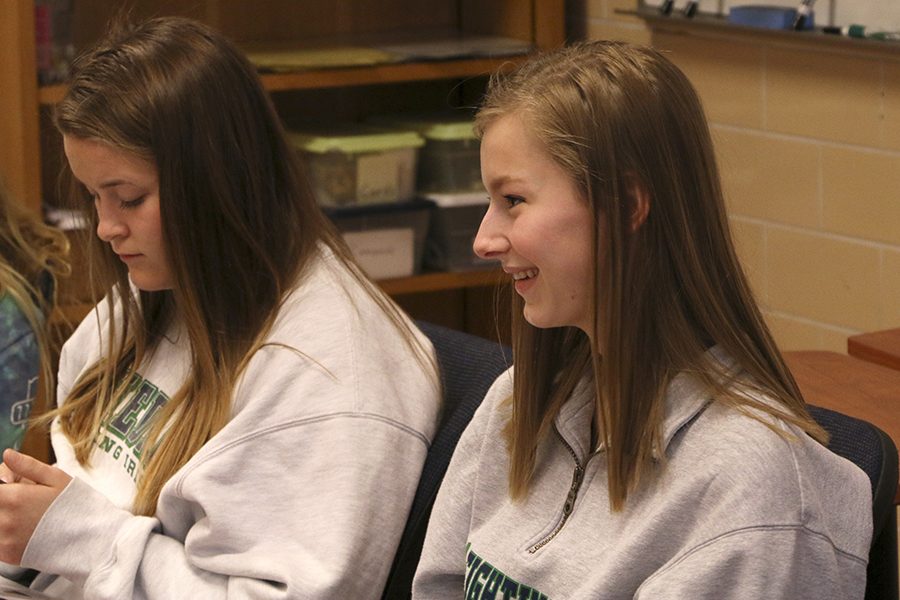Dutch student reflects on reasons for enrollment
“I liked Cathedral the best” said Queis
Juniors Hannah Tuttle and Helen Queis talk with other students in their county on Friday March 24 during flex. “(In the U.S.), school is more like a community, more family,” Queis said.
Traveling thousands of miles across the world to go to school may sound daunting to some, but several students here have done exactly that. One student who understands all about moving to the United States to go to school is junior Helen Queis, who enrolled here during the third quarter.
“I moved (to the U.S.) sophomore year, so almost two years,” Queis said about her length of time residing in America.
Initially, Queis enrolled at the International School of Indiana, which is located at 200 W. 49th St. “My old school was really small, and I wanted something bigger,” Queis said about her reason for transferring here.
Queis also said that academics contributed to her choice. “I am doing the IB program and there are not many schools who have the IB program and out of the ones I shadowed, I liked Cathedral the best,” Queis said.
Although Queis did not originally begin her studies in the U.S., she said she has noticed differences in education between here and the Netherlands. One aspect that is different is the atmosphere.”(In the U.S.), school is more like a community, more family,”Queis said.
According to Queis, in the Netherlands school is more academically focused.
She said that the way in which classes are taken are different. “In the Netherlands, high school is six years instead of four years,” Queis said.
According to IB co-coordinator Mr. Harold Spooner, European schooling differs in how students are taught. In particular, he said that the way math may be presented in the Netherlands is different.
“(Dutch students) don’t take algebra, geometry, calculus. (They are) put all together in what is called an integrated math course,” Spooner said.
Coming to a new school means needing to assimilate into a new environment. This can affect the beginning days there. According to Queis, she said that her initial start at the school was lively. “My first week at Cathedral was busy getting to know a lot of people and getting used to a bigger school,” Queis said.
Part of adjusting to a new school is meeting new teachers.
According to Spooner, he said that he first met Queis when she shadowed. He said that they spoke about her IB courses and she seemed like she would be a good addition to the school.
“(Helen) seemed like an impressive student,” Spooner said.
French teacher Mr. Gary Spurgin and English teacher Mrs. Lizabeth Bradshaw noticed upon first meeting Queis that she seemed introverted. Spurgin, however, found that she was ready to participate.
“(Helen is) very open, very willing to share (and) to express opinions,” Spurgin said.
According to Bradshaw, she said that at first she found Queis shy and quiet. Despite this, her view of Helen changed after a short time of interaction.
“After only two weeks, I can tell that (Queis) is very confident and social,” Bradshaw said.
According to Queis, she would tell other students from other countries to come to the school if they are traveling to the U.S. to obtain an education. She said that it is nice to have friends from other countries and it is probably different in the U.S. than in any other country.
She also said that she thinks Cathedral is close knit. “(The school) is big in the sense that you can’t know everyone, but you can recognize people’s faces and say hi (to them),” Queis said.
Teachers may find it somewhat challenging to connect with students from other countries who are enrolled in their classes.
According to Bradshaw, when instructing a student from another country, teachers should engage them in dialogue. She said that educators should start the conversation about where the student comes from and who they are.
“Unless you seek out some of (a student’s) experiences and ask them questions, you might miss out on learning about (that student’s) culture,” Bradshaw said.
Spurgin expressed a similar sentiment.
According to Spurgin, he said that teachers should praise the differences in students from across the world. However, he said that they should not expect the same type of thinking or response from that student.
“Tap into what that student brings. It could be the way (a student) has learned something in their country and how they have been taught the could be very different from how we teach it,” Spurgin said.
Embracing these differences could make one feel more at home at the school.
According to Queis, students from other countries should stay open minded about the way things are done in the U.S.
Queis said, “(The American) culture will be different, but be adaptive while still keeping your own culture and ideas.”







